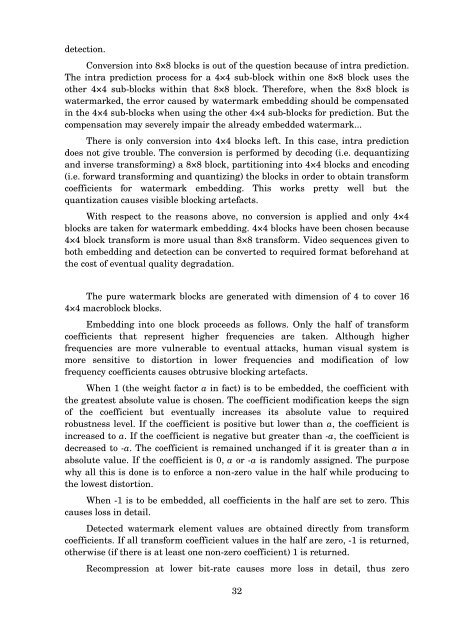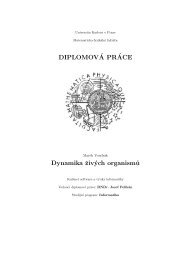MASTER THESIS Video Watermarking - Computer Graphics Group ...
MASTER THESIS Video Watermarking - Computer Graphics Group ...
MASTER THESIS Video Watermarking - Computer Graphics Group ...
Create successful ePaper yourself
Turn your PDF publications into a flip-book with our unique Google optimized e-Paper software.
detection.<br />
Conversion into 8×8 blocks is out of the question because of intra prediction.<br />
The intra prediction process for a 4×4 sub-block within one 8×8 block uses the<br />
other 4×4 sub-blocks within that 8×8 block. Therefore, when the 8×8 block is<br />
watermarked, the error caused by watermark embedding should be compensated<br />
in the 4×4 sub-blocks when using the other 4×4 sub-blocks for prediction. But the<br />
compensation may severely impair the already embedded watermark...<br />
There is only conversion into 4×4 blocks left. In this case, intra prediction<br />
does not give trouble. The conversion is performed by decoding (i.e. dequantizing<br />
and inverse transforming) a 8×8 block, partitioning into 4×4 blocks and encoding<br />
(i.e. forward transforming and quantizing) the blocks in order to obtain transform<br />
coefficients for watermark embedding. This works pretty well but the<br />
quantization causes visible blocking artefacts.<br />
With respect to the reasons above, no conversion is applied and only 4×4<br />
blocks are taken for watermark embedding. 4×4 blocks have been chosen because<br />
4×4 block transform is more usual than 8×8 transform. <strong>Video</strong> sequences given to<br />
both embedding and detection can be converted to required format beforehand at<br />
the cost of eventual quality degradation.<br />
The pure watermark blocks are generated with dimension of 4 to cover 16<br />
4×4 macroblock blocks.<br />
Embedding into one block proceeds as follows. Only the half of transform<br />
coefficients that represent higher frequencies are taken. Although higher<br />
frequencies are more vulnerable to eventual attacks, human visual system is<br />
more sensitive to distortion in lower frequencies and modification of low<br />
frequency coefficients causes obtrusive blocking artefacts.<br />
When 1 (the weight factor a in fact) is to be embedded, the coefficient with<br />
the greatest absolute value is chosen. The coefficient modification keeps the sign<br />
of the coefficient but eventually increases its absolute value to required<br />
robustness level. If the coefficient is positive but lower than a, the coefficient is<br />
increased to a. If the coefficient is negative but greater than -a, the coefficient is<br />
decreased to -a. The coefficient is remained unchanged if it is greater than a in<br />
absolute value. If the coefficient is 0, a or -a is randomly assigned. The purpose<br />
why all this is done is to enforce a non-zero value in the half while producing to<br />
the lowest distortion.<br />
When -1 is to be embedded, all coefficients in the half are set to zero. This<br />
causes loss in detail.<br />
Detected watermark element values are obtained directly from transform<br />
coefficients. If all transform coefficient values in the half are zero, -1 is returned,<br />
otherwise (if there is at least one non-zero coefficient) 1 is returned.<br />
Recompression at lower bit-rate causes more loss in detail, thus zero<br />
32
















